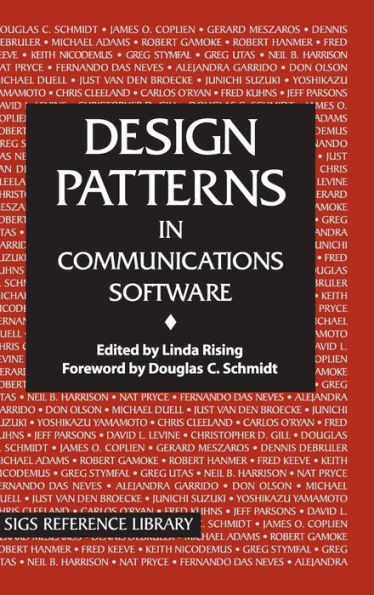Design Patterns in Communications Software available in Hardcover

Design Patterns in Communications Software
- ISBN-10:
- 0521790409
- ISBN-13:
- 9780521790406
- Pub. Date:
- 07/23/2001
- Publisher:
- Cambridge University Press
- ISBN-10:
- 0521790409
- ISBN-13:
- 9780521790406
- Pub. Date:
- 07/23/2001
- Publisher:
- Cambridge University Press

Design Patterns in Communications Software
Hardcover
Buy New
$129.00Overview

Product Details
| ISBN-13: | 9780521790406 |
|---|---|
| Publisher: | Cambridge University Press |
| Publication date: | 07/23/2001 |
| Series: | SIGS Reference Library , #19 |
| Pages: | 562 |
| Product dimensions: | 5.98(w) x 9.02(h) x 1.38(d) |
About the Author
Read an Excerpt
1: Design Patterns in Telecommunications System Architecture
Abstract
The telephone network could be called the world's first distributed computing network. People in telecommunications treat as second nature many of the issues just surfacing in other problem domains. This article describes some of the techniques used in the telecommunications industry to deal with highly distributed high-reliability systems. A number of recurring patterns are identified and used to describe the design of the telecommunications network and its components.
Telephony has even more acronyms than computing, because we've had 50 more years to come up with them.
Telephone pioneer to young turk, 1981
Since Alexander Graham Bell made the first phone call, the telecommunications industry has been constantly striving to produce a more reliable and feature-rich telecommunications network. As evi- dence of their success, telephone service is something we all take pretty much for granted. Even when disaster strikes, such as the big San Francisco earthquake of 1989, the phone system continues to work when all other utilities are knocked out.
Being a well-established industry, the telecommunications industry has a rich set of patterns that are used to solve commonly occurring problems. It is through the use of these patterns that the highly stringent requirements of the network are met. Many of these patterns are visible to the operators of the telecom network, while others are only visible to those building the equipment from which the telecom network is assembled. This chapter focuses on the use of design patterns, as exemplified in the book Design Patterns1, in the architecture and construction of the telephone network and its elements.
The Telephony Background
Telephone networks are complex distributed systems with a long and colorful heritage. The domain has a number of inherent challenges. These include the physical distribution of the network and the need for reliability and high capacity. To meet the reliability and capacity challenges, the designers of the telephone network and its components have introduced even more distributed processing. The resulting system is distributed in many dimensions, and this distribution must be handled to ensure that reliability is increased rather than decreased.
Objects
Telephone switching systems do not have a "main" program: there are many different activities going on inside the system at any time. As a result, these systems have always had to be decomposed into smaller components. The protocols used in communication between such components usually contain an identifier of the object being affected, typically the call or the facility the call is using. This, and specification techniques such as Systems Description Language (SDL), have naturally led to switching systems being implemented using object-based techniques long before object orientation was fashionable.
Inherent Distribution
At the simplest end of the scale, a typical basic telephone call requires coordination of resources and actions across many telephone switching systems (aka switches) and other network elements. The coordination is carried out through the use of protocols between the switches. In the early days, this signaling was done using electrical pulses that told electromechanical "steppers," a hardware implementation of a 10-ary tree, which outgoing circuit to select.As the network evolved, steppers were replaced by electromechanical logic boards, and ultimately by stored-program-controlled switching mechanisms. As the capabilities of the switches improved, it was possible to upgrade the signaling, first with the addition of multifrequency tones and later with digital messaging. Originally, only digits representing the called party were signaled. Using tones instead of pulses decreased the time required to communicate the information about the desired call, thus allowing more information to be sent, such as call type and billing indicators. Later, information about the calling party was added to the protocols. A key factor driving the richness of the signaling protocols was the desire to support features across the network.
After the basic call, the first significant networked feature was Inward gyre Area Telephone Service (INWATS). This service, now called 800, Tollfree, or Freephone, necessitated the signaling of the whereabouts of the calling party relative to the final destination of the call to give the terminating switching office enough information to generate the appropriate billing records. The details of the protocols (using fancy called-number manipulation) are beyond the scope of this article; suffice it to say that this was truly a case of trying to make a single call "object" appear simultaneously in several telephone switches.
